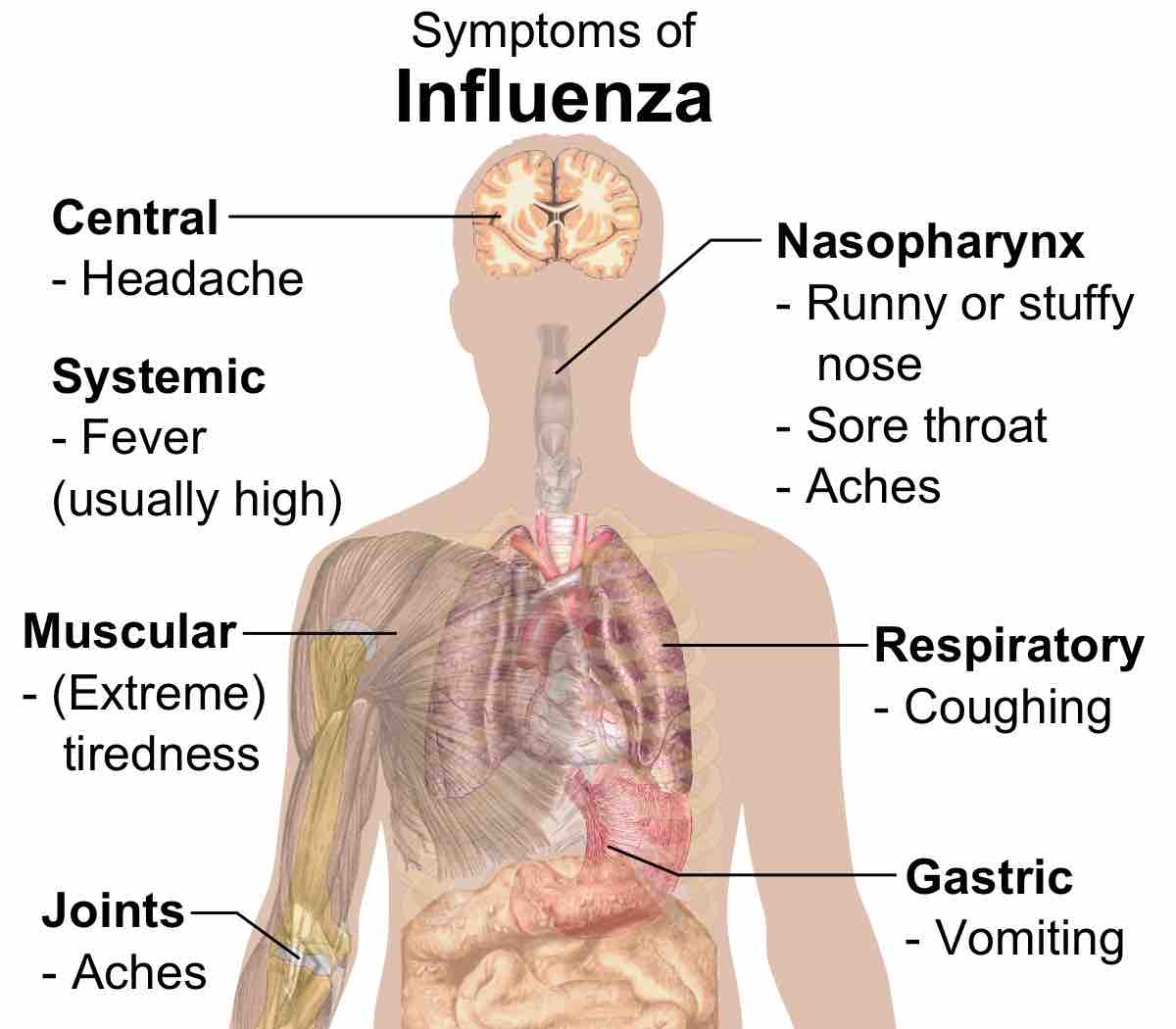Influenza, commonly referred to as the flu, is an infectious disease caused by RNA viruses of the family Orthomyxoviridae that affects birds and mammals. The most common symptoms of the disease are chills, fever, sore throat, muscle pains, severe headache, coughing, weakness/fatigue, and general discomfort. Although it is often confused with other influenza-like illnesses, especially the common cold, influenza is a more severe disease than the common cold. The general symptoms of influenza are summarized in .

Symptoms of influenza
Symptoms of influenza with fever and cough the most common symptoms.
Typically, influenza is transmitted through the air by coughs or sneezes, creating aerosols containing the virus. Influenza can also be transmitted by direct contact with bird droppings or nasal secretions, or through contact with contaminated surfaces. Reasonably effective ways to reduce the transmission of influenza include good personal health and hygiene habits such as: not touching your eyes, nose or mouth; frequent hand washing, covering coughs and sneezes, avoiding close contact with sick people and staying home yourself if you are sick.
Vaccinations against influenza are usually made available to people in developed countries. The most common human vaccine is the trivalent influenza vaccine (TIV) that contains purified and inactivated antigens against three viral strains. Typically, this vaccine includes material from two influenza A virus subtypes and one influenza B virus strain. The TIV carries no risk of transmitting the disease, and it has very low reactivity. A vaccine formulated for one year may be ineffective in the following year, since the influenza virus evolves rapidly, and new strains quickly replace the older ones.
Influenza viruses A, B, and C are very similar in overall structure and a diagram of the structure of the virus can be seen in Figure 2. The viral particles of all influenza viruses are similar in composition. They are made of a viral envelope containing two main types of glycoproteins, wrapped around a central core. The central core contains the viral RNA genome and other viral proteins that package and protect this RNA. RNA tends to be single stranded, but in special cases it is double. Unusually for a virus, its genome is not a single piece of nucleic acid but seven or eight pieces of segmented negative-sense RNA. Each piece of RNA contain either one or two genes, which code for a gene product (protein). Hemagglutinin (HA) and neuraminidase (NA) are the two large glycoproteins on the outside of the viral particles. HA is a lectin that mediates binding of the virus to target cells and entry of the viral genome into the target cell, while NA is involved in the release of progeny virus from infected cells, by cleaving sugars that bind the mature viral particles. Furthermore, they are antigens to which antibodies can be raised. Influenza A viruses are classified into subtypes based on antibody responses to HA and NA. These different types of HA and NA form the basis of the H and N distinctions in, for example, H5N1. There are 16 H and 9 N subtypes known, but only H 1, 2, and 3, and N 1 and 2 are commonly found in humans.
Antiviral medication can be effective, but some strains of influenza can show resistance to the standard antiviral drugs. The two classes of antiviral drugs used against influenza are neuraminidase inhibitors and M2 protein inhibitors (adamantane derivatives). Neuraminidase inhibitors are currently preferred for flu virus infections since they are less toxic and more effective.
Coryza is a word describing the symptoms of a "cold. " It describes the inflammation of the mucous membranes lining the nasal cavity which usually gives rise to the symptoms of nasal congestion and loss of smell, among other symptoms. Coryza may not always have an infectious or allergenic etiology and can be due to something as innocuous as a cold wind, spicy food, or tender points in the muscles of the neck such as the sternocleidomastoid. It is also a symptom of narcotic withdrawal. Coryza is classically used in association with the "four Cs" of measles infection: cough, conjunctivitis, Koplik's spots, and coryza.
Treatment of coryza depends on etiology. Coryza from any allergic causes usually gets relieved if contact with the allergen (dust, pollen, cold wind, etc.) is avoided. Nasal sprays, antihistamines, and decongestants are beneficial. However, if it is due to any virus it usually takes three to seven days to improve.